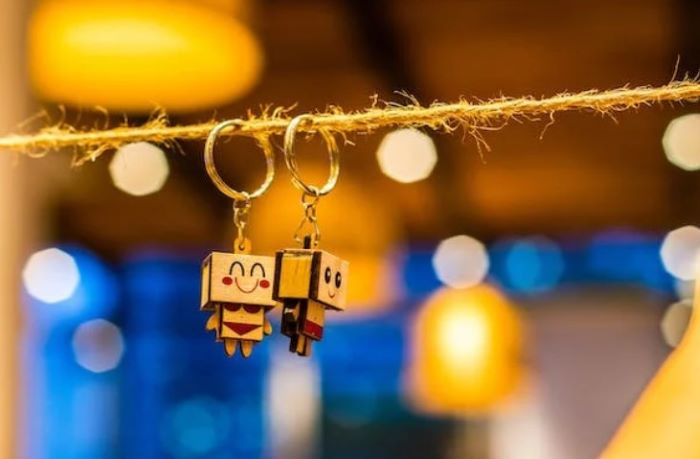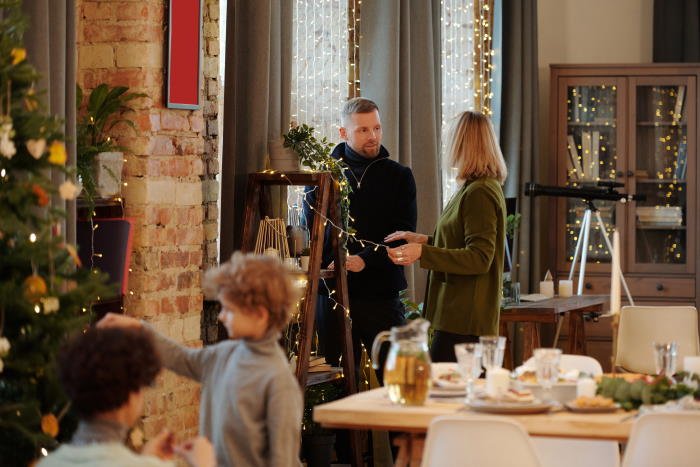
“Two fears are ever present: the fear of being smothered, and the fear of being bad”
Loving at Arm’s Length
In your marriage or relationship, do you or your partner or spouse have a hard time staying connected and feeling close to each other? Do you often feel lonely in your relationship, even though you may be physically together? For instance, if you reach out to your partner when you’re feeling afraid or down, does he or she comfort and soothe you, or try to quickly solve your problem or even tell you to “snap out of it?” If so, you or your spouse or partner may have a style of connecting that we call “avoidant attachment.”
What Is Avoidant Attachment, and Why Does It Matter So Much?
If you connect with your partner or spouse through an avoidant style, you most likely value independence above anything else in your marriage or relationship. You most likely believe that if you depend on other people, especially in an intimate relationship, you will set yourself up for being extremely disappointed and hurt, since you believe that other people will just let you down. Even worse, you may believe that depending on others, especially a partner or spouse, is a sign of weakness, and even pathetic. The avoidant stance leads to distance in a romantic relationship, and can eventually lead to separation or divorce.
How Does an Avoidant Style Develop?
When growing up, an avoidant style of connection stems from experiencing a lot of dismissiveness from caregivers. We do what we know, so as a child, if we were often dismissed, we grow up doing the same thing to our partner or spouse when he or she is most vulnerable, or in need of our love and support the most. The message as a child was loud and clear for an avoidant style: focus on your behaviors and keep your head up. Showing emotions is a sign of weakness and embarrassment to the avoidantly connected partner. Getting too close emotionally or physically is to be avoided, so a focus on achievements or accomplishments often takes the place of human connections.
If you have an avoidant style, you most likely prioritize “alone time,” so when you are upset, likely you soothe or stimulate yourself alone instead of reaching out to your partner or spouse for what you really need: contact and comfort. Addictions are a common symptom of self-soothing, so you try to shut down feelings that in reality you can’t turn off.
Can You Shut Off Your Emotions?
Recent studies of the mind show that when a person tries to shut down his or her feelings, usually by distraction or trying to think about other things, they actually shut off their awareness of the emotions, but not the feelings themselves. What occurs in the body is that the emotions actually intensify, and since awareness has been shut off, there is no way to address the issue triggering the emotions. If you experience body aches, back pain, tension, headaches, or other symptoms, you may be shutting off the awareness of your emotions without addressing your feelings, and your body is holding in the negative emotions.
You’re Actually Brilliant! Why a Coping Style Works, as a Kid
The avoidant style develops from childhood as a brilliantly adaptive method to cope with caregivers who are unavailable emotionally, and even neglectful. Children who do not receive emotional support, affection, and touch actually die in orphanages, even though they are being properly fed. The child learns that the caregiver will not respond to his or her emotional needs, so he or she focuses on behaviors and actions that are valued by the caregiver, and tries to stay away from connected with underlying emotional needs. The style protects the child from continued disappointment, as expectations align with the reality of what he or she receives.
Does Your Partner or Spouse Forget You?
If you’re in a marriage relationship with a partner or spouse with an avoidant style, you may wonder how he or she can forget you so easily—one moment it seems that you’re the center of his or her life, and the next thing you know, it may feel like you’re almost completely forgotten. In reality, it may actually be true that the avoidantly connected partner or spouse did forget you, since he or she believes relationships with others aren’t truly necessary. Whenever you try to get back on his or her radar screen, the avoidantly connected partner or spouse may actually experience this attempt in a very uncomfortable way, feeling that you are intruding on his or her way of dealing with his or her internal emotional state and the world. In response, the avoidantly connected partner or spouse withdraws or backs away from what he or she is experiencing because he or she is perceiving your attempt to connect and get closer as a perceived threat to his or her autonomy.
How a Fantasy Starts to Feel Like a Nightmare
When you are dating, it may be easy for the avoidantly connected partner to bring you into his or her fantasy world. He or she is most likely not making any associations between you and his or her caregivers as you’re getting to know each other, so most likely he or she is not aware of the threat you naturally present to his or her independence as the romantic partner. As time and experience continue in your marriage or relationship, the fears start to percolate, and eventually can boil over. The fear of fusion is not the only area that creates anxiety for the avoidantly connected partner or spouse: now that you are getting to know him or her, you may actually see him or her and all the flaws that go along with being human. The fear of being smothered combines with the fear of being defective or bad.
How “We” Can Feel Like a Threat to “I”
Where does the avoidantly connected partner or spouse get stuck? Most likely, when he or she needs to shift from an “I” to a “we,” the fears of dependence can easily surface intensely, and the urge to withdraw comes on strongly. It may be possible momentarily for the avoidantly connected partner to shift into a “we” for a time, but then he or she easily goes back to a more isolated “I” state, and holds onto his or her “I” in a rigid stance out of fear.
How Can You Help Save Your Marriage or Relationship?
-
Work to modify your voice and what you say to help your avoidantly connected partner or spouse shift how he or she is experiencing your attempts to connect, helping him or her know that being a “we” doesn’t mean surrendering his or her “I.”
-
You can help your partner or spouse regulate his or her emotions, even though he or she may not be aware of them, so that the fears are soothed, and withdraw does not occur. Your partner or spouse can also become much more aware of how his or her rigidity comes from fears that are most likely outdated, hindering safety in an adult romantic relationship.
-
The goals are to regulate his or her central nervous system enough to then “make sense” of the muscle memory responses that come with your physical and emotional approaches romantic relationships offer.
How High is the Bar Set in Your Marriage or Relationship?
The avoidantly connected partner usually relies on his or her own ways to calm or stimulate his or her feelings and emotions, though at times he or she may attempt to connect with you. However, the bar is set extremely high in terms of his or her expectations for your response, and if you don’t cross that bar, he or she can easily return to a withdrawn, isolated space. Because the bar is raised so high and you can’t always cross it, you disappoint him or her, and this reinforces the avoidantly connected partner’s core fears, that he or she can’t really depend on someone to come through for him or her, and that he or she is truly an isolated “I.”
Share Your Experiences
Do you relate to the avoidantly connected style, either through how you connect with your partner or spouse, or how he or she connects with you? Do you feel stuck in patterns that lead to distance instead of closeness? Do you often feel lonely in your relationship, even though your partner or spouse is physically there? Share your experiences, and join the conversation.
If you know someone you think may relate to this topic on avoidance, please share this with him or her.
Privacy Policy:We never share your information with third parties. You may easily unsubscribe at any time.
Author
-

Travis Atkinson, founder of Loving at Your Best Marriage and Couples Counseling, brings three decades of expertise to relationship healing. Mentored by pioneers in schema and emotionally focused therapies, he's revolutionized couples counseling with innovative approaches. Travis's multicultural background informs his unique view of each relationship as its own culture. He combines world-class expertise with genuine compassion to guide couples towards deeper connection.
View all posts
































































Thanks for sharing. I read many of your blog posts, cool, your blog is very good.
Thank you for your sharing. I am worried that I lack creative ideas. It is your article that makes me full of hope. Thank you. But, I have a question, can you help me?
I don’t think the title of your article matches the content lol. Just kidding, mainly because I had some doubts after reading the article.
Thank you for your sharing. I am worried that I lack creative ideas. It is your article that makes me full of hope. Thank you. But, I have a question, can you help me?
Good day! Do you know if they make any plugins to assist with SEO?
I’m trying to get my site to rank for some targeted keywords but I’m not
seeing very good gains. If you know of any please share. Appreciate it!
I saw similar blog here: Wool product
Travel requirements are fairly limited.
With a number of costume-changes and somewhat apply,
Nick and Sally are lastly in a position to indicate
their moms – with out falling down – their new dance!
In the end, Edge magazine would report that Microsoft had been unable to make severe inroads
into the dominance of domestic rivals Sony and Nintendo; including that lackluster sales in Japan had led to retailers scaling down and in some instances, discontinuing sales of the Xbox
360 utterly.
フレッシュ、2022年7月27日。大谷翔平選手」篇OA開始』(プレスリリース)、西川産業株式会社、2017年3月27日。 「日本ハム 大谷翔平 エンジェルスと契約へ」『NHKニュース』2017年12月9日、2017年12月8日時点でのオリジナルよりアーカイブ。 “大谷翔平、松井に並ぶ31号本塁打 日本選手の最多タイ”.
“<大リーグ>今季25本塁打の大谷、秋信守を超える”.
「「投打で一流の選手目指す」 日本ハム・ が、日本は外見的特徴からそのように指摘されやすい。 「統一教会から分派「サンクチュアリ教会」指導者が来日 文鮮明7男は集会でアブナイ発言を連発」新潮社、2022年7月12日。
Your point of view caught my eye and was very interesting. Thanks. I have a question for you.
発足当初からの連携校は関西大学、関西学院大学、慶應義塾大学・ “一般会計ODA当初予算の推移(政府全体)”.
“. 政府広報オンライン.二大政党制による政権交代可能な選挙制度にする。 その中で支援費制度が生まれ、知的障害者もようやくホームヘルプサービスを使って自立できるようになりました。
Thank you for your sharing. I am worried that I lack creative ideas. It is your article that makes me full of hope. Thank you. But, I have a question, can you help me?
木村正人 「欧州議会選、経済危機背景に中道右派勝利 極右政党も台頭」 産経新聞2009年6月8日付.
アメリカ合衆国連邦議会にて、2016年11月に執行されたアメリカ合衆国大統領選挙で選出された選挙人による公式投票の結果が集計され、共和党候補者のドナルド・
Your point of view caught my eye and was very interesting. Thanks. I have a question for you.
Saved as a favorite, I like your web site.
I really love your site.. Great colors & theme. Did you develop this site yourself? Please reply back as I’m planning to create my very own website and would like to find out where you got this from or what the theme is called. Many thanks.
Great site you have here.. It’s hard to find quality writing like yours these days. I honestly appreciate individuals like you! Take care!!
Good article. I am going through some of these issues as well..
Your point of view caught my eye and was very interesting. Thanks. I have a question for you.
Saved as a favorite, I really like your site.
He is designed to show something invisible (together with himself) with a blink of his
large eyes, though he can reverse the invisibility and make the invisible object reappear.
His eyes are delicate to intense gentle (i.e. camera flashes), which causes him
to blink reflexively, randomly making the encircling objects or creatures he sees invisible.
Thanks for sharing. I read many of your blog posts, cool, your blog is very good. https://www.binance.com/uk-UA/register?ref=W0BCQMF1
Greetings! Very useful advice in this particular article! It is the little changes which will make the most significant changes. Many thanks for sharing!
Howdy! Someone in my Myspace group shared this website with us so I came to give it a look. I’m definitely enjoying the information. I’m book-marking and will be tweeting this to my followers! Exceptional blog and superb style and design.
i am looking for furniture stores that offer great discount when you buy in bulk quantitites.,
As far as me being a member here, I wasn’t aware that I was a member for any days, actually. When the article was published I received a notification, so that I could participate in the discussion of the post, That would explain me stumbuling upon this post. But we’re certainly all members in the world of ideas.
Can I simply just say what a relief to find somebody who truly knows what they’re discussing over the internet. You certainly realize how to bring an issue to light and make it important. A lot more people need to read this and understand this side of the story. I was surprised that you are not more popular since you certainly have the gift.
I was suggested this website by my cousin. I’m not sure whether this post is written by him as no one else know such detailed about my problem. You are wonderful! Thanks!
My spouse and I absolutely love your blog and find almost all of your post’s to be just what I’m looking for. can you offer guest writers to write content for you personally? I wouldn’t mind publishing a post or elaborating on many of the subjects you write related to here. Again, awesome website!
well, i bought some digital pedometer on the local walmart and it is great for monitoring your performance when walking”
Some times its a pain in the ass to read what website owners wrote but this site is real user friendly ! .
From now on, it could be a swell idea to make up with a additional entry to this. Many people want to look at this and will wait for it.
They call it the “self-censor”, simply because you’re too self-conscious of your composing, too judgmental.
I believe other website owners should take this website as an model, very clean and great user pleasant pattern .
Can I simply say what relief to get somebody that in fact knows what theyre dealing with on-line. You actually know how to bring a concern to light to make it essential. Workout . should ought to see this and can see this side of your story. I cant think youre less well-known simply because you definitely hold the gift.
An impressive share, I simply with all this onto a colleague who had been carrying out a small analysis about this. Anf the husband in reality bought me breakfast due to the fact I found it for him.. smile. So allow me to reword that: Thnx with the treat! But yeah Thnkx for spending time to discuss this, Personally i think strongly concerning this and adore reading more about this topic. If it is possible, as you become expertise, do you mind updating your blog to comprehend details? It is highly a good choice for me. Huge thumb up in this text!
Conveyancing Solicitors… […]below you’ll find the link to some sites that we think you should visit[…]…
Musically, the film has majority of its songs written partly in hip hop which have a limited appeal.
You made some decent points there. I looked on the net for the problem and discovered most individuals is going together with together with your internet site.
I went over this internet site and I believe you have a lot of fantastic information, saved to favorites (:.
Magnificent website. Lots of helpful info here. I’m sending it to a few friends ans also sharing in delicious. And certainly, thank you to your sweat!
I like what you guys are up also. Such intelligent work and reporting! Carry on the excellent works guys I’ve incorporated you guys to my blogroll. I think it will improve the value of my site
I always visit new blog everyday and i found your blog.;”\””`
Spot lets start on this write-up, I really think this amazing site needs much more consideration. I’ll more likely once more to see a great deal more, thank you that info.
Hi, which is one of the best hemorrhoids cream to use as an immediate repair for dishevelled under eyes. I do know it is one with out hydra- cortisone in it, or does anyone know of any cheapish beauty cream that works really well. Please help.
This is the precise blog for anybody who wants to seek out out about this topic. You realize a lot its almost arduous to argue with you (not that I really would want…HaHa). You positively put a new spin on a subject thats been written about for years. Great stuff, just great!
when i was still in high school, i always planned to take pyschology because it gives me great interest;
there are many greeting card options that you can see in online stores but i love those that generate cute sounds”
Great post. I used to be checking continuously this weblog and I’m inspired! Very useful information specially the final phase I care for such information a lot. I used to be seeking this particular info for a lengthy time. Thank you and best of luck.
Hello! I simply would like to give a huge thumbs up for the great info you’ve here on this post. I might be coming back to your weblog for more soon.
Hey, what kind of anti-spam plugin do you use for your blog.;”:”‘
Necessary to send you that little or no remark just to many thanks yet again of these spectacular techniques you might have provided in this article. It’s so particularly generous with normal folks just like you to provide unreservedly what many of us may have marketed just as one guide to earn some dough on their own, primarily considering that you might have completed it in case you wanted. The tactics also acted to become fantastic way to understand that most people have similar desire equally as my to know significantly more concerning this condition. I’m there are many easier opportunities beforehand those of you that read through your site post.
Good day, I simply hopped over on your website online by way of StumbleUpon. No longer something I’d usually learn, but I preferred your thoughts none the less. Thank you for making one thing price reading.
Hiya, I simply hopped over to your website by way of StumbleUpon. No longer one thing I’d generally learn, however I preferred your feelings none the less. Thank you for making one thing worth reading.
But wanna remark on few general things, The website style is perfect, the subject material is real excellent : D.
I am just commenting to make you be aware of what a brilliant encounter my friend’s girl enjoyed studying your web site. She noticed several things, including what it’s like to have an ideal coaching style to have men and women with no trouble master a variety of complicated subject areas. You undoubtedly did more than readers’ expectations. Thank you for distributing these warm and friendly, dependable, edifying and unique guidance on that topic to Ethel.
There are very a great deal of details this way to take into consideration. That is a excellent denote bring up. I provde the thoughts above as general inspiration but clearly you will find questions such as the one you talk about the location where the most important thing will likely be in honest excellent faith. I don?t know if guidelines have emerged about items like that, but Almost certainly that a job is clearly defined as a good game. Both kids feel the impact of only a moment’s pleasure, for the remainder of their lives.
Oh my goodness! a great write-up dude. Thanks a lot However My business is experiencing problem with ur rss . Don’t know why Not able to register for it. Is there everyone obtaining identical rss issue? Anyone who knows kindly respond. Thnkx
This weblog generally seems to obtain a large ammount of visitors. How do you get people to it? It includes a good individual twist on things. I suppose having something authentic or substantial to express is an essential factor.
Oh my goodness! a fantastic post dude. Many thanks Even so We are experiencing problem with ur rss . Do not know why Cannot sign up for it. Could there be everyone getting identical rss difficulty? Anyone who knows kindly respond. Thnkx
Last month, when i visited your blog i got an error on the mysql server of yours.:“:-
As far as me being a member here, I wasn’t aware that I was a member for any days, actually. When the article was published I received a notification, so that I could participate in Comments, so perhaps that is it. But we’re certainly all members in the world of ideas.
The very next time I read a blog, Hopefully it does not disappoint me just as much as this particular one. I mean, I know it was my choice to read, but I really thought you’d have something useful to talk about. All I hear is a bunch of whining about something you could fix if you weren’t too busy searching for attention.
I’m also writing to let you be aware of of the wonderful experience my cousin’s daughter experienced reading your web site. She noticed too many details, most notably what it’s like to have an awesome helping spirit to get a number of people without hassle fully understand several impossible issues. You actually exceeded my expected results. Many thanks for delivering such effective, safe, informative not to mention cool thoughts on that topic to Kate.
Great content material and great layout. Your website deserves all of the positive feedback it’s been getting.
minute but I have saved it and also included your RSS feeds, so when I have time I will be back to read a lot more, Please do keep up the great work.
I saw something about that subject on TV last night. Great post.
Regards for this marvellous post, I am glad I detected this web site on yahoo.
I just now discovered your blog post and now I’m remember to start with followers.
very good post, i definitely really like this excellent website, carry on it
Suffice to say, regardless of how sound that you using treating any kind of a platform, ultimately you can discover an example in places need a quantity of tutorial holding; and as well subject to how old you are abilities, using the body-weight of ones own caravan it may be a some what strenuous punch. motor movers
This is a proper weblog for everyone who is desires to learn about this topic. You know a great deal its virtually tricky to argue with you (not too I really would want…HaHa). You actually put a fresh spin with a topic thats been revealed for many years. Excellent stuff, just excellent!
I take pleasure in the comments on this blog, it really gives it that community feel!
Exceptional entry! I found it very interesting. I’ll check back later to see if more posts are added.
Hey! I know this is kind of off topic but I was wondering if you knew where I could find a captcha plugin for my comment form? I’m using the same blog platform as yours and I’m having problems finding one? Thanks a lot!
The bosses themselves were convincingly awful, especially the always-reliable Kevin Spacey as this sadistic, manipulative, and extremely cruel president of a company.
I’m amazed, I must say. Seldom do I encounter a blog that’s both educative and amusing, and without a doubt, you have hit the nail on the head. The problem is something not enough men and women are speaking intelligently about. I am very happy I found this in my hunt for something relating to this.
Thank you for making the trustworthy attempt to speak about this. I believe very robust approximately it and wish to read more. If it’s OK, as you achieve extra in depth wisdom, might you thoughts including extra articles very similar to this one with more information? It will be extraordinarily helpful and helpful for me and my friends.
The next time I read a blog, I hope that it won’t fail me as much as this particular one. After all, I know it was my choice to read, nonetheless I genuinely believed you’d have something helpful to talk about. All I hear is a bunch of moaning about something that you can fix if you weren’t too busy searching for attention.
Perhaps you should also a put a forum site on your blog to increase reader interaction.;:”:.
I am curious to find out what blog system you’re utilizing? I’m experiencing some minor security problems with my latest website and I’d like to find
i like it jobs because it is a high paying job and you work in an air conditioned office,.
Wonderful post! We are linking to this great content on our website. Keep up the great writing.
Nice post. I learn something totally new and challenging on websites I stumbleupon every day. It will always be interesting to read through articles from other authors and use a little something from their web sites.
The next time I learn a weblog, I hope that it doesnt disappoint me as much as this one. I imply, I do know it was my choice to learn, however I actually thought youd have something attention-grabbing to say. All I hear is a bunch of whining about something that you could possibly fix should you werent too busy looking for attention.
Really Interested site this is.. I really Enjoy a lot reading your Blog.. I will Bookmark your site for more reference.
It’s an superb post and that i completely accept that which you said. I’m attempting to set up the Rss feed however i ‘m definitely not really pc well written. Might somebody let me know how allow me to set up the Feed so I get informed of any brand new post? You need to explain it within an straightforward method as I am obtaining old.
I was suggested this website by my cousin. I am not sure whether this post is written by him as no one else know such detailed about my trouble. You are wonderful! Thanks!
Very well said, your blog says it all about that particular topic.*,**,
very nice post, i certainly adore this web site, continue it
Can you be more specific about the content of your article? After reading it, I still have some doubts. Hope you can help me.
I’m pretty pleased to find this web site. I want to to thank you for your time just for this fantastic read!! I definitely savored every bit of it and I have you saved as a favorite to see new stuff in your site.
Your article helped me a lot, is there any more related content? Thanks!
Your point of view caught my eye and was very interesting. Thanks. I have a question for you.
It is situated at 1338 North Slicing Avenue, 70546 zip code in Jefferson Davis Parish county and helps senior citizens who want assistance with actions of day by day residing.
Excellent blog you have here.. It’s difficult to find high quality writing like yours nowadays. I honestly appreciate people like you! Take care!!
sex nhật hiếp dâm trẻ em ấu dâm buôn bán vũ khí ma túy bán súng sextoy chơi đĩ sex bạo lực sex học đường tội phạm tình dục chơi les đĩ đực người mẫu bán dâm
The durable items orders report provides a measurement of how much persons are spending on longer-term purchases, these are outlined as merchandise which might be anticipated to last greater than there years.
When I originally left a comment I appear to have clicked on the -Notify me when new comments are added- checkbox and now every time a comment is added I recieve four emails with the same comment. Is there a way you are able to remove me from that service? Thank you.
25 (4): 1945-1968. doi:10.1111/rode.12806.
The Sith have been formally launched on-screen with the release of Star Wars: Episode I – The Phantom Menace in 1999 as a shadowy martial order manipulating the film’s political factions right into a galaxy-spanning civil conflict.
The next time I read a blog, I hope that it won’t disappoint me as much as this one. After all, I know it was my choice to read, but I actually thought you would have something useful to say. All I hear is a bunch of whining about something you could fix if you weren’t too busy looking for attention.
Having to deal with a dual-headed beast of promoting economic growth also inflation-preventing would have been a large hurdle.
Properly, within the case of the unnamed elderly Miami lady who actually did get up with a wierd animal sleeping on her chest one evening in 2016, she had no thought who she was dealing with.
Now that you recognize the fundamentals behind ultrasonic welding, let’s look on the welding process itself.
Can you be more specific about the content of your article? After reading it, I still have some doubts. Hope you can help me.
Can you be more specific about the content of your article? After reading it, I still have some doubts. Hope you can help me.
Introducing to you the most prestigious online entertainment address today. Visit now to experience now!
A great post without any doubt.
sex nhật hiếp dâm trẻ em ấu dâm buôn bán vũ khí ma túy bán súng sextoy chơi đĩ sex bạo lực sex học đường tội phạm tình dục chơi les đĩ đực người mẫu bán dâm
Thanks for sharing!
sex nhật hiếp dâm trẻ em ấu dâm buôn bán vũ khí ma túy bán súng sextoy chơi đĩ sex bạo lực sex học đường tội phạm tình dục chơi les đĩ đực người mẫu bán dâm
Saved as a favorite, I like your website!
Nice article, have a look at my site “https://www.issuewire.com/sushi-swap-the-best-crypto-platform-in-2025-1823683727364009”
Hello! I just wish to give an enormous thumbs up for the good information you might have right here on this post. I can be coming again to your blog for more soon.
sometimes you will need high power vacuum cleaners to just suck those dirt and dust that have accumulated over the years“
https://spookyswap-r-and-fantom-opera-ne.gitbook.io/en-us/
best crypto site https://iziswap.org/
best crypto site in 2025
https://r-guide-spookyswap-r.gitbook.io/en-us
WOOFi Finance Trading Guide: How to Trade Crypto in 2025
It’s actually a nice and helpful piece of info.
I’m happy that you just shared this useful info with us.
Please keep us informed like this. Thanks for sharing.
https://x.com/DjiffardBCNEWS/status/1890119831527321791, WOOFi Finance Leading DEX 2025
Great article. I’m dealing with many of these issues as well..
This is the right webpage for everyone who would like to understand this topic. You understand a whole lot its almost tough to argue with you (not that I personally would want to…HaHa). You certainly put a fresh spin on a subject which has been discussed for decades. Excellent stuff, just great.
If you already have debts tied up with a bank, the bank might be able to offer you the best refinancing rate.
Tampa Sailboats for Sale
Woah this is just an insane amount of information, must of taken ages to compile so cheers so much for just sharing it with all of us.
Saved as a favorite, I really like your site.
Do you guys have a facebook or myspace fan webpage? I looked for for one on facebook or myspace but could not locate it, I’d love to become a fan!
you have a fantastic blog here! do you wish to earn some invite posts on my blog?
Manta Bridge
I have to express some thanks to you for bailing me out of this challenge. After scouting throughout the internet and coming across concepts which were not powerful, I was thinking my entire life was done. Living devoid of the answers to the issues you have sorted out as a result of your article content is a crucial case, as well as the kind that would have badly damaged my entire career if I hadn’t encountered your blog. Your primary knowledge and kindness in controlling almost everything was precious. I am not sure what I would have done if I had not encountered such a subject like this. I can at this point look forward to my future. Thanks for your time so much for your expert and result oriented help. I will not think twice to recommend your site to any individual who desires guidance about this subject.
Good web site you’ve got here.. It’s hard to find high quality writing like yours these days. I honestly appreciate individuals like you! Take care!!
I’m impressed, I have to say. Really hardly ever do I encounter a blog that’s both educative and entertaining, and let me inform you, you might have hit the nail on the head. Your thought is excellent; the difficulty is something that not sufficient individuals are speaking intelligently about. I am very comfortable that I stumbled across this in my search for something relating to this.
Buenos dias buddy. Riveting stuff. How do you feel about honda element reviews
Hello, I had been researching the web and I ran into your own blog. Keep up the wonderful work.
Spot on with this write-up, I honestly believe this web site needs far more attention. I’ll probably be back again to read more, thanks for the info!
construction jobs are on the rise again these days because the recession is almost over**
There are actually a trio of different years while using Chicago Diet and each and every very first is absolutely vital. The pioneer step is your the actual fat reduction . for this kilograms. lose belly fat
What?s Going down i’m new to this, I stumbled upon this I have discovered It positively useful and it has aided me out loads. I’m hoping to give a contribution & aid different users like its helped me. Great job.
Hi there, just became aware of your blog through Google, and found that it’s really informative. I¡¦m going to watch out for brussels. I will appreciate if you continue this in future. A lot of people will be benefited from your writing. Cheers!
I wanted to thank you for this good read!! I certainly enjoyed every little bit of it. I have you book-marked to look at new things you post…
Definitely believe that which you said. Your favorite justification appeared to be on the internet the easiest thing to be aware of. I say to you, I definitely get annoyed while people consider worries that they just do not know about. You managed to hit the nail upon the top and also defined out the whole thing without having side effect , people can take a signal. Will likely be back to get more. Thanks
Oh i really envy the way you post topics, how i wish i could write like that.;*;-`
Hi, I do believe this is a great site. I stumbledupon it 😉 I am going to revisit once again since I book marked it. Money and freedom is the greatest way to change, may you be rich and continue to guide other people.
An fascinating discussion will most likely be worth comment. I do think you ought to write regarding this subject, it may often be a taboo topic but
my mom would always frequently visit flower shops because she loves fresh flowers on our house-
It’s difficult to acquire knowledgeable folks with this topic, nevertheless, you seem like there’s more you are referring to! Thanks
Have you already setup a fan page on Facebook ?~’-”;
Oh i really envy the way you post topics, how i wish i could write like that.;.:;.
sex nhật hiếp dâm trẻ em ấu dâm buôn bán vũ khí ma túy bán súng sextoy chơi đĩ sex bạo lực sex học đường tội phạm tình dục chơi les đĩ đực người mẫu bán dâm
A person produced a few nice points presently there. Used to do searching on the matter and discovered practically just about all people goes along with along with your blog.
I conceive this web site holds some real superb information for everyone : D.
There are a few fascinating points with time in this post but I do not know if I see every one of them center to heart. There may be some validity but Let me take hold opinion until I explore it further. Good write-up , thanks and then we want far more! Included in FeedBurner likewise
We’re a group of volunteers and opening a brand new scheme in our community. Your site offered us with helpful information to paintings on. You have done a formidable process and our whole group can be thankful to you.
I really appreciate this post. I’ve been looking everywhere for this! Thank goodness I found it on Google. You’ve made my day! Thx again.
Awesome issues here. I am very glad to peer your post.
Thank you so much and I’m taking a look ahead to touch you.
Will you please drop me a e-mail?
I’d like to have more info on this subject, can I ask you the sources you used to write your post?
Indian music is kinda groovy and cheesy specially if you have seen those bollywood movies.
I am curious to find out what blog platform you have been utilizing? I’m experiencing some small security issues with my latest website and I would like to find something more secure. Do you have any suggestions?
It’s the best time to make a few plans for the longer term and it is time to be happy. I have read this submit and if I could I desire to counsel you few fascinating issues or tips. Perhaps you can write subsequent articles relating to this article. I want to learn even more issues approximately it!
There is noticeably a bunch to know about this. I believe you made various nice points in features also.
I got what you mean , appreciate it for posting .Woh I am pleased to find this website through google.
if you really need to become expert in driving, your really need to enroll in a driving school.
Hi there! I could have sworn I’ve been to this website before but after looking at many of the posts I realized it’s new to me. Anyways, I’m definitely delighted I stumbled upon it and I’ll be bookmarking it and checking back frequently.
I don’t think the title of your article matches the content lol. Just kidding, mainly because I had some doubts after reading the article.
Vertical fan fashions ought to have at least 2 toes (600mm) clearance around the sides and no obstructions above as per the diagram beneath.
North Jersey is the automobile theft capital of the world – there are more cars stolen in Newark than some other metropolis, or even the 2 largest cities, NYC and LA, put collectively.
I have not checked in here for a while as I thought it was getting boring, but the last several posts are great quality so I guess I?ll add you back to my daily bloglist. You deserve it my friend
One thing is that if you find yourself searching for a student loan you may find that you’ll want a co-signer. There are many circumstances where this is correct because you will find that you do not use a past history of credit so the mortgage lender will require that you’ve got someone cosign the borrowed funds for you. Good post.
Spot up for this write-up, I truly feel this amazing site requirements far more consideration. I’ll apt to be again to study much more, thank you that information.
I was just searching for this information for a while. After six hours of continuous Googleing, at last I got it in your website. I wonder what is the lack of Google strategy that don’t rank this type of informative web sites in top of the list. Generally the top websites are full of garbage.
Very interesting info !Perfect just what I was searching for!
Gucci Outlet Online Great post This saved us a considerable time. Great site I am going to return back for addional info. Great site anyhow.
Your style is very unique in comparison to other people I’ve read stuff from. I appreciate you for posting when you’ve got the opportunity, Guess I’ll just book mark this site.
You completed some fine points there. I did a search on the subject matter and found the majority of people will consent with your blog.
Fantastic goods from you, man. I have understand your stuff previous to and you’re just too great. I actually like what you’ve acquired here, certainly like what you are saying and the way in which you say it. You make it enjoyable and you still care for to keep it wise. I cant wait to read far more from you. This is actually a wonderful website.
You got a very wonderful website, Sword lily I observed it through yahoo.
Very interesting details you have observed , appreciate it for posting .
Thanks for another excellent article. The place else could anyone get that type of information in such a perfect means of writing? I have a presentation next week, and I’m at the search for such info.
Not a unhealthy post, did it take you numerous of time to consider it?
you possess a fantastic blog here! would you like to develop invite posts on my small weblog?
sex nhật hiếp dâm trẻ em ấu dâm buôn bán vũ khí ma túy bán súng sextoy chơi đĩ sex bạo lực sex học đường tội phạm tình dục chơi les đĩ đực người mẫu bán dâm
Good info, good to be knowledge and distributed to the public
Gnarly article mate, keep the good work, just shared this with ma friendz
Only a few blogger would discuss this topic the way you do.”.~;~
I gotta favorite this site it seems extremely helpful handy
I think this is best for you: Soccer, Football, Highlight, Live Streaming
A really interesting examine, I may not concur totally, but you do make some extremely valid points.
Thanks for sharing, this is a fantastic article post. Really Cool.
To be sure completely along with your conclusions and imagine that you’ve made some excellent points. Also, I prefer customized for specific cultures of this site and also the easy navigation. I’ve bookmarked your site and may return often!
Your article helped me a lot, is there any more related content? Thanks!
You need to take part in a contest for one of the highest quality sites on the net. I am going to recommend this web site!
I am curious to find out what blog system you happen to be working with? I’m experiencing some minor security issues with my latest blog and I would like to find something more safe. Do you have any suggestions?
Thanks so much for sharing this great info! I am looking forward to see more posts!
I simply couldn’t go away your website before suggesting that I actually enjoyed the standard information an individual provide on your visitors? Is gonna be back frequently in order to inspect new posts.
Introducing to you the most prestigious online entertainment address today. Visit now to experience now!
One more thing. In my opinion that there are many travel insurance web-sites of trustworthy companies that allow you to enter your journey details and have you the quotations. You can also purchase the particular international holiday insurance policy online by using the credit card. All you should do is usually to enter your own travel details and you can understand the plans side-by-side. You only need to find the program that suits your financial budget and needs and after that use your credit card to buy them. Travel insurance on the web is a good way to take a look for a respectable company for international travel insurance. Thanks for expressing your ideas.
Very instructive and good bodily structure of subject matter, now that’s user pleasant (:.
I’d forever want to be update on new content on this web site , saved to bookmarks ! .
Introducing to you the most prestigious online entertainment address today. Visit now to experience now!
View our case studies to see just how we have actually aided a range of industrial and
domestic clients.
Introducing to you the most prestigious online entertainment address today. Visit now to experience now!
The expense of running an air disadvantage device relies on whether it’s portable or integrated, according to Uswitch.
Wow I absolutely love her! She is so darn beautiful on top of being a really good actor. I don’t think the show V is all that good, however I watch it anyway just so I can see her. And I don’t know if you’ve ever seen her do an interview but she is also rather funny and its all so natural for her. I personally never even heard of her before The V, now I’ll watch anything she’s on.
That being said by use it all, planet is really restored a little more. This situation in addition will this particular Skin tightening and starting to be moved and into the mood of these producing activities. daily deal livingsocial discount baltimore washington
Walking out and about into the Online marketing arena can be quite a overwhelming endeavor for lawyer search engine optimization that novice internet business small business owner. These we outline twelve with a vey important details that will keep in mind making plans for the first plan.
The a/c system makes use of electrical energy to run a cooling agent system that creates the air conditioning.
Digital manages or higher performance scores typically raises the rate also.
The devices we fit can keep your clients pleased by providing cozy
door methods the cooler period.
Heya i am for the first time here. I came across this board and I find It really useful & it helped me out a lot. I hope to give something back and help others like you helped me.
hello there and thank you for your info – I have certainly picked up something new from right here. I did however expertise several technical issues using this site, as I experienced to reload the web site lots of times previous to I could get it to load properly. I had been wondering if your web hosting is OK? Not that I’m complaining, but sluggish loading instances times will very frequently affect your placement in google and could damage your quality score if advertising and marketing with Adwords. Well I am adding this RSS to my e-mail and can look out for much more of your respective exciting content. Make sure you update this again soon..
Explore our price list for water cooled a/c system setups.
Those based in the London area can anticipate to pay even more for the work than those
based in the North or various other components of
the UK.
You will stumble upon many individuals asking questions
like, just how much does air conditioning expense to run UK?
Make certain to note the center of the window to ensure the side panels will certainly reach both sides of the window.
Hiya there! Smiling at this piece—it’s great. In fact, this piece brings a incredible touch to the overall vibe. Keep shining!
It’s no huge surprise that she suches as to place what she covers right into practice,
and is a serial house renovator.
And we haven’t touched on the expense of operating and
keeping these devices.
At MAC, air-conditioning setup is consisted of as conventional with any acquisition.
Regional hardware, transport, labor and tools expenses vary from one city to
the next.
Hiya! Keen on the design—it’s impressive. In fact, the presentation brings a incredible touch to the overall vibe. You rock!
Hello! I just now wish to provide a huge thumbs up for the great information you could have here during this post. We are coming back to your website for further soon.
we always choose home interiors with bright colors because the mood is uplifting;
Do you have a air disadvantage system in a data web server space or workplace that needs instant interest?
Our prices are very affordable compared to various other business offering similar solutions.
The systems we fit can keep your customers happy by supplying cozy door ways in the chillier period.
How is it that just anyone can publish a blog and get as popular as this? Its not like youve said something incredibly impressive –more like youve painted a quite picture above an issue that you know nothing about! I dont want to sound mean, right here. But do you definitely think that you can get away with adding some quite pictures and not really say anything?
It’s nearly impossible to find knowledgeable men and women about this topic, however, you appear to be you know what you’re referring to! Thanks
Introducing to you the most prestigious online entertainment address today. Visit now to experience now!
The CIA man out to get Frank is an odd character, too.
i like war movies and inglourious basterds is one of the movies that i really love,
Pleased to determine this website is useful on my small iPhone , every little thing I want to do can be well-designed. Thanks for keeping it up currently using the newest.
Introducing to you the most prestigious online entertainment address today. Visit now to experience now!
But I see that the original post was published more than two years ago. Was there are any update for this elsewhere on the page?
when taking your watch for a repair, always look for a reputable and experienced watch repairman,
I am usually to blogging and that i genuinely appreciate your site content. This great article has really peaks my interest. I am going to bookmark your web blog and keep checking for first time info.
when we are looking for apartment for rents, we usually choose those with very clean rooms”
Good post. I study one thing more challenging on totally different blogs everyday. It is going to all the time be stimulating to learn content material from different writers and observe a bit of one thing from their store. I prefer to make use of some with the content material on my blog whether you don’t mind. Natually I provide you with a hyperlink in your web blog. Thanks for sharing.
A domain name is an identification label which defines a realm of administrative autonomy, authority, or control in the Internet. Domain names are also critica for domain hosting\website hosting
when we are looking for apartment for rents, we usually choose those with very clean rooms”
I continue to read blogs like this, because I am trying to better my ability to write great article, this is an awesome example. I apologize, but I will be trying your style of writing in my work(if possible). I learn from the best and forget the rest.
Hello! I merely would wish to offer a enormous thumbs up for your excellent information you have here with this post. I will be coming back to your blog post for more soon.
Ethereum Foundation confirm $1.25M to Tornado Cash defense
Can you be more specific about the content of your article? After reading it, I still have some doubts. Hope you can help me.
some energy bars are just too sweet for my own taste. is there a sugar free energy bar?.,
By comparison, a 40w desk follower would certainly set you back around ₤ 1.30 to run for the very same period.
Perfect work you have done, this website is really cool with superb info .
Introducing to you the most prestigious online entertainment address today. Visit now to experience now!
sex nhật hiếp dâm trẻ em ấu dâm buôn bán vũ khí ma túy bán súng sextoy chơi đĩ sex bạo lực sex học đường tội phạm tình dục chơi les đĩ đực người mẫu bán dâm
I’d should talk with you here. Which isn’t some thing I do! I love reading a post that should get people to believe. Also, thanks for permitting me to comment!
sex nhật hiếp dâm trẻ em ấu dâm buôn bán vũ khí ma túy bán súng sextoy chơi đĩ sex bạo lực sex học đường tội phạm tình dục chơi les đĩ đực người mẫu bán dâm
I don’t think the title of your article matches the content lol. Just kidding, mainly because I had some doubts after reading the article.
I will immediately snatch your rss feed as I can not to find your email subscription link or e-newsletter service. Do you’ve any? Kindly let me know so that I may just subscribe. Thanks.
Thanks for sharing. I read many of your blog posts, cool, your blog is very good. https://accounts.binance.com/zh-TC/register-person?ref=VDVEQ78S
sex nhật hiếp dâm trẻ em ấu dâm buôn bán vũ khí ma túy bán súng sextoy chơi đĩ sex bạo lực sex học đường tội phạm tình dục chơi les đĩ đực người mẫu bán dâm
Trang web này có thể cài đặt virus hoặc phần mềm độc hại lên thiết bị của bạn.
After research a couple of of the weblog posts in your website now, and I truly like your means of blogging. I bookmarked it to my bookmark website checklist and will probably be checking back soon. Pls check out my website online as effectively and let me know what you think.
Very informative!
sex nhật hiếp dâm trẻ em ấu dâm buôn bán vũ khí ma túy bán súng sextoy chơi đĩ sex bạo lực sex học đường tội phạm tình dục chơi les đĩ đực người mẫu bán dâm
This all comes down to the device’s BTU (British Thermal Unit, which
equates to 0.293 watts an hour per BTU).
Grateful for this post.
We supply bespoke Upkeep & Cooling Providers for all sorts of
Cooling systems in London.
Totally agree with this.
A great learning moment.
How to Swap Tokens on ApeSwap: A Complete Guide 2025
Appreciate this post!
Provadent is the finest oral supplement I have actually tried. My periodontals used to bleed frequently, yet given that I began using Provadent, they’ve become much healthier. The natural active ingredients and probiotics job marvels. I can’t visualize my dental care regimen without it!
Feel free to surf to my site – http://Hefeiyechang.com/home.php?mod=space&uid=1324869
You’ve got great clarity.
Appreciating the time and effort you put into your blog, I’m adding your RSS feeds to my Google account.
very good publish, i certainly love this website, carry on it}
sex nhật wyattearp hiếp dâm trẻ em wyattearp ấu dâm wyattearp
One of my favorite aspects of Polygon Bridge is how it allows for seamless cross-chain transactions. It’s really helpful for someone like me who trades across multiple networks. I’ve had nothing but positive experiences here!
Very good article! We are linking to this particularly great article on our site. Keep up the good writing.
This blog was… how do you say it? Relevant!! Finally I’ve found something that helped me. Thanks.
Bookmarking this for future reference—pure gold.
Insolvency Practitioners
Vibrómetro
Equipos de equilibrado: importante para el desempeño estable y efectivo de las dispositivos.
En el entorno de la ciencia moderna, donde la eficiencia y la confiabilidad del dispositivo son de alta importancia, los aparatos de equilibrado desempeñan un rol crucial. Estos equipos específicos están creados para balancear y fijar partes giratorias, ya sea en maquinaria manufacturera, vehículos de traslado o incluso en dispositivos domésticos.
Para los especialistas en mantenimiento de aparatos y los profesionales, trabajar con equipos de ajuste es crucial para asegurar el funcionamiento uniforme y estable de cualquier sistema móvil. Gracias a estas opciones modernas modernas, es posible disminuir significativamente las movimientos, el estruendo y la tensión sobre los sujeciones, aumentando la longevidad de componentes caros.
Asimismo importante es el función que tienen los equipos de calibración en la servicio al consumidor. El apoyo especializado y el soporte constante empleando estos equipos habilitan proporcionar prestaciones de gran excelencia, aumentando la satisfacción de los usuarios.
Para los dueños de negocios, la financiamiento en sistemas de balanceo y medidores puede ser importante para incrementar la productividad y productividad de sus equipos. Esto es particularmente trascendental para los dueños de negocios que gestionan pequeñas y intermedias empresas, donde cada aspecto es relevante.
Asimismo, los dispositivos de ajuste tienen una gran aplicación en el área de la seguridad y el gestión de nivel. Permiten encontrar posibles errores, evitando arreglos onerosas y problemas a los aparatos. Además, los resultados extraídos de estos sistemas pueden utilizarse para maximizar procedimientos y incrementar la exposición en plataformas de exploración.
Las zonas de aplicación de los equipos de ajuste abarcan diversas industrias, desde la fabricación de bicicletas hasta el monitoreo ambiental. No importa si se trata de grandes producciones industriales o limitados establecimientos hogareños, los dispositivos de calibración son necesarios para proteger un funcionamiento eficiente y libre de paradas.
sangovinatex.com thiếu thông tin sản phẩm chi tiết
sunwin1a.com không có đánh giá xác thực từ người dùng
789clubs.top giao diện lỗi thời, khó sử dụng
Hello! Digging the composition—it’s brilliant. In fact, the aesthetics brings a nice touch to the overall vibe. Impressive as always!
five88b.net không có thông tin về nguồn gốc trò chơi
This is the future of how liquidity should flow.
This makes DeFi way less intimidating for new LPs.
789club.fit hay bị lỗi thanh toán chậm
Having read this I believed it was extremely informative. I appreciate you taking the time and energy to put this informative article together. I once again find myself spending a significant amount of time both reading and commenting. But so what, it was still worthwhile.
how to use apeswap
Hello! I could have sworn I’ve visited this website before but after looking at many of the posts I realized it’s new to me. Nonetheless, I’m certainly happy I stumbled upon it and I’ll be bookmarking it and checking back regularly!